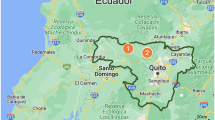Abstract
Female white-footed micePeromyscus leucopus (Rafinesque, 1818) and their dependent offspring were monitored in nest boxes to determine the extent and causes of nest mortality. The mortality of dependent young was high (561 of 838; 66%) and variable among years. Most mortality involved the loss of entire litters (112 of 183 litters; 61%), with half of these losses attributed to the death of lactating females before the young were weaned (59 of 112 litters; 53%). Most mortality was from unknown causes, although infanticide, energetic constraints and predation were identified in a small number of cases. Predation is likely the major source of mortality in this population.
Similar content being viewed by others
References
Boyce C. C. K. and Boyce J. L. III. 1988. Population biology ofMicrotus arvalis. I. Lifetime reproductive success of solitary and grouped breeding females. Journal of Animal Ecology 57: 711–722.
Chitty D. 1952. Mortality among voles (Microtus agrestis) at Lake Vyrnwy, Montgomeryshire in 1936-39. Philosophical Transactions of the Royal Society, Series B. 236: 505–552.
Chitty D. and Phipps E. 1966. Seasonal changes in survival in mixed populations of two species of vole. Journal of Animal Ecology 35: 313–331.
Cole F. R. and Batzli G. O. 1978. Influence of supplemental feeding on a vole population. Journal of Mammalogy 59: 809–819.
Gaines M. S. and Rose R. K. 1976. Population dynamics ofMicrotus ochrogaster in eastern Kansas. Ecology 57: 1145–1161.
Getz L. L. 1960. A poulation study of the vole, Microtus pennsylvanicus. American Midland Naturalist 64: 392–405.
Getz L. L., Sims L. E. and McGuire B. 2000. Nestling survival and population cycles in the prairie vole,Microtus ochrogaster. Canadian Journal of Zoology 78: 1723–1731.
Godfrey G. K. 1955. Observations on the nature of the decline in numbers of twoMicrotus populations. Journal of Mammalogy 36: 209–214.
Golley F. B. 1961. Interaction of natality, mortality and movement during one annual cycle in aMicrotus population. American Midland Naturalist 66: 152–170.
Graham I. M. and Lambin X. 2002. The impact of weasel predation on cyclic field-vole survival: the specialist predator hypothesis contradicted. Journal of Animal Ecology 71: 946–956.
Goundie T. R. and Vessey S. H. 1986. Survival and dispersal of young white-footed mice born in nest boxes. Journal of Mammalogy 67: 53–60.
Havelka M. A. and Millar J. S. 2000. Use of artificial nest sites as a function of age of litter inPeromyscus leucopus. American Midland Naturalist 144: 152–158.
Havelka M. A. and Millar J. S. (in press). Maternal age drives seasonal variation in litter size ofPeromyscus leucopus. Journal of Mammalogy.
Hoffmann R. S. 1958. The role of reproduction and mortality in population fluctuations of voles (Microtus). Ecological Monographs 28: 79–109.
Innes D. G. L. and Millar J. S. 1990. Number of litters, litter size and survival in two species of microtines at two elevations. Holarctic Ecology 13: 207- 216.
Koivula M., Koskela E., Mappes T. and Oksanen T. A. 2003. Cost of reproduction in the wild: Manipulation of reproductive effort in the bank vole. Ecology 84: 398–405.
Krebs C. J. 1964. The lemming cycle at Baker Lake, Northwest Territories, during 1959-62. Arctic Institute of North America Technical Paper Number 15: 1–104.
Krebs C. J. and DeLong K. T. 1965. AMicrotus population with supplemental food. Journal of Mammalogy 46: 566–573.
Krebs C. J. and Myers J. H. 1974. Population cycles in small mammals. Advances in Ecological Research 8: 267–399.
Millar J. S., Burkholder D. and Lang T. 1986. Estimating age at independence inPeromyscus populations. Canadian Journal of Zoology 64: 910–913.
Millar J. S. and McAdam A. G. 2001. Life on the edge: the demography of short-season populations of deer mice. Oikos 93: 69–76.
Nadeau J. H. 1985. Ontogeny. [In: Biology of New WorldMicrotus. R. H. Tamarin, ed]. Special Publication Number 8, The American Society of Mammalogists: 254-285.
Reid D. G., Krebs C. J. and Kenney A. 1995. Limitation of collared lemming population growth at low densities by predation mortality. Oikos 73: 387–389.
Wolff J. O. and Cicirello D. M. 1989. Field evidence for sexual selection and resource competition infanticide in white-footed mice. Animal Behavior 38: 637–642.
Ylönen H., Koskela E. and Mappes T. 1997. Infanticide in the bank vole (Clethrionomys glareolus): occurrence and the effect of familiarity on female infanticide. Annales Zoologici Fennici 34: 259–266.
Author information
Authors and Affiliations
Additional information
Associate Editor was Joseph F. Merritt.
Rights and permissions
About this article
Cite this article
Miliar, J.S., Havelka, M.A. & Sharma, S. Nest mortality in a population of small mammals. Acta Theriol 49, 269–273 (2004). https://doi.org/10.1007/BF03192526
Received:
Accepted:
Issue Date:
DOI: https://doi.org/10.1007/BF03192526




